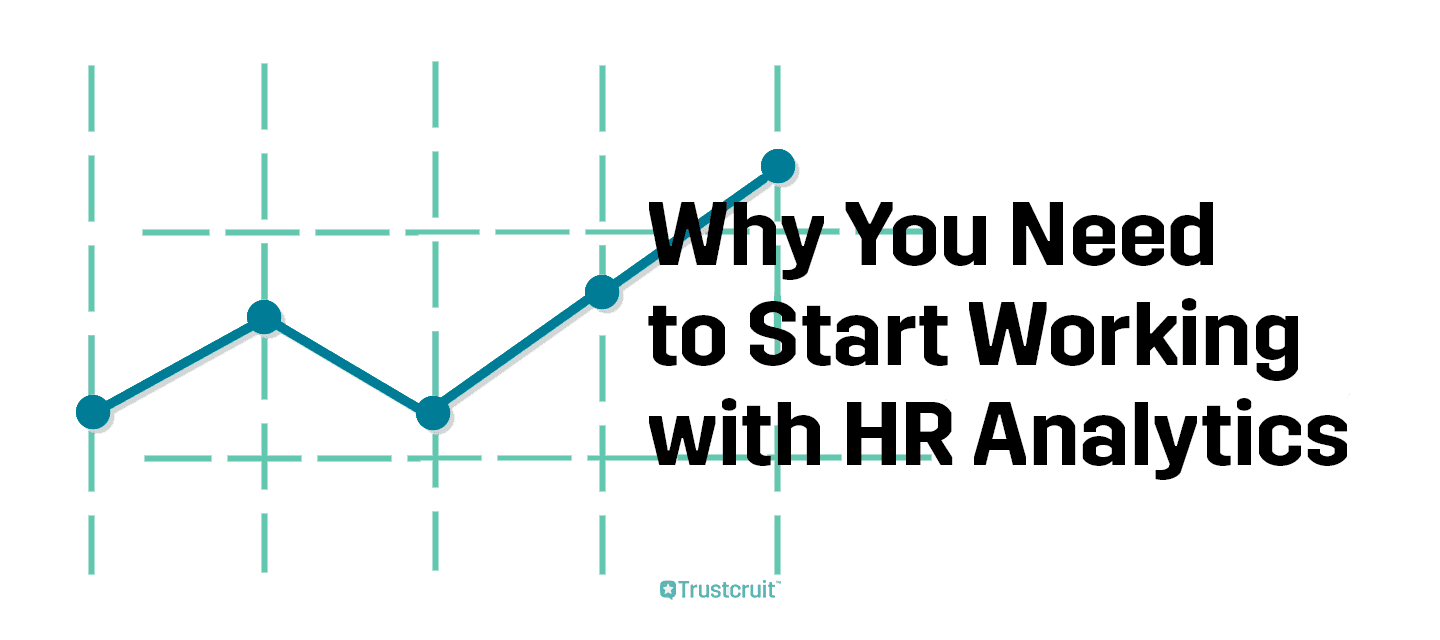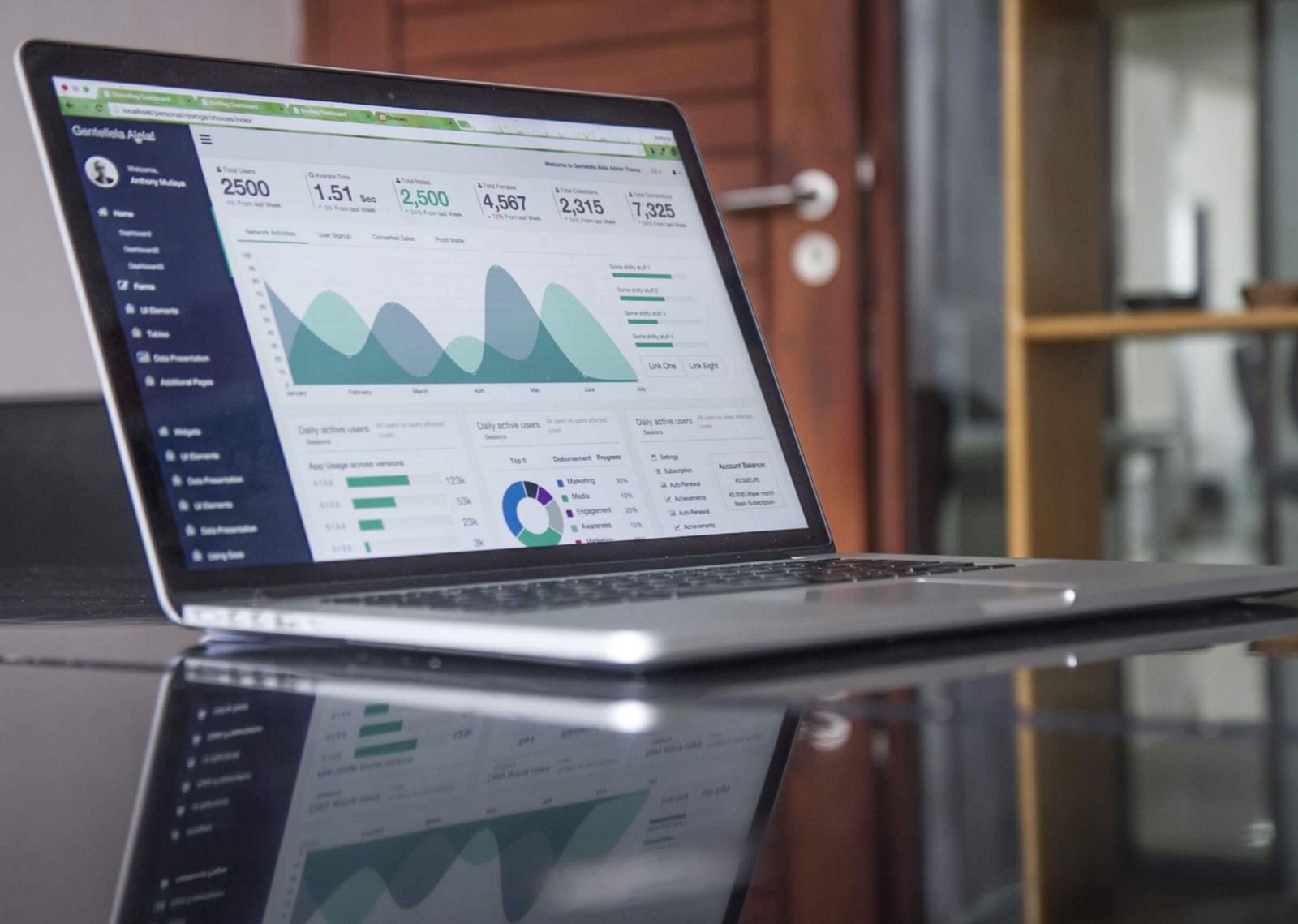
Olle Zander
Marketing Manager at Trustcruit
Why You Need to Start Working With HR Analytics
HR Analytics haven't gotten the attention it deserves. We’re going to explain how you can change that.
— Denna sida är också tillgänglig på Svenska 
Traditionally, larger enterprises haven’t given human resources (HR) and HR analytics the attention it deserves. Period.
So, in this article we’re going to explain one simple way you can change that.
Spoiler alert: The solution is HR analytics.
The data accumulated by HR analytics empowers businesses to optimize their workforce and hiring strategies, which ultimately leads to a boost in revenue.
Does that sound good to you? Great, because below is a guide that breaks down everything you need to know about HR analytics.
So, without further ado, let’s jump right in!

What’s HR Analytics?
In short, HR analytics (also known as ‘people analytics’) provides the tools you need to analyze the skills, knowledge, and experience possessed by your employees.
This same platform also examines these moving pieces to reveal the impact they have on your organization’s revenue. So, in a nutshell, the aim of HR analytics is to provide HR managers with a better insight into their human resource strategies. With this data at the ready, it’s easier to pinpoint weaknesses in your recruiting methods and, subsequently, make necessary improvements.
Although your workforce isn’t directly linked to the profits on your accounting spreadsheet, HR mismanagement can waste thousands of dollars.
For example, high turnover rates aren’t just an inconvenience, they’re also a financial drain. Someone has to spend time and resources recruiting and training new employees. Then while the new hire is learning the ropes, your company’s efficiency will inevitably take a hit, which, of course, eats into your bottom line.
The stats speak for themselves, in the UK and US roughly $37 billion a year is wasted on unproductive employees! It stands to reason when it takes two people to do a job (the trainee and the supervisor); your company swallows the value of an entire annual salary (at the very least)!
HR analytics looks at how efficient, satisfied, and reliable your workforce is, as well as the likelihood of employees quitting, or falling behind on their work. But, in addition to all of that, HR analytics also provides you with the data you need to enhance both your candidate experience and recruitment process.
It’s also worth mentioning, you can use this same software to find out the following information:
- Your employee turnover rate
- The percentage of that turnover that’s a regrettable loss
- The experience and satisfaction of candidates during the recruitment process
- On the balance of probabilities, which employees will leave your organization within a year.
The latter point is worth its weight in gold. When you can identify which employees are likely to leave your company in the lurch, you can then take action to try and stop that happening. For instance, refining your recruitment process and company culture to boost your employee retention rate.
So with all that in mind, let’s take a more in-depth look at some of the more important HR analytic metrics…
Employee Churn Rate
As you’ve probably already gathered, ’employee churn’ is the metric to use for assessing your workforce’s turnover rate. But, ’employee church rate’ goes one step further than that, because it also predicts your future churn rate.
Of course, knowledge is power, so once you know these figures, you’ll be in a better position to create and execute an action plan for reducing employee churn.
Capability Analytics
The skills and expertise of your employees have a massive bearing on the success of your business. As such, keeping an eye on your ‘Capability’ analytics is essential. Namely, because this metric helps you oversee your talent management processes. Using this data, you can accurately identify the core competencies of your workforce.
Once you know what your team excels at, you can then set a benchmark standard for new recruits. But more importantly, you’ll also be able to identify any skills your team lacks and tweak your hiring strategy accordingly.
Organizational Culture Analytics
For years, company culture has been tough to quantitatively analyze. Primarily because ‘culture’ (usually) comprises a set of unwritten expectations, standards, behaviors, and procedures that form the ethos of your office.
But, with the help of the ‘Organizational Culture’ metric, you can examine your company’s culture objectively. This puts you in a better place to track any changes in your business’s culture (be it positive or negative).
But, most importantly, you’ll start to get a feel for the early signs of a healthy workplace culture that’s beginning to turn toxic. This is essential for nipping any undesirable behaviors and practices in the bud. Allowing negative vibes to creep into the office will eventually wreak havoc on your staff turnover rate.
The key takeaway: In the long run, it’s unwise to neglect this metric…otherwise, it will only come back to bite you.

Capacity Analytics
Put simply, ‘Capacity’ analytics help you establish the operational efficiency of your workforce. This data pinpoints your most profitable tasks and highlights whether your team spends sufficient time on these revenue-generating activities. If not, you can then better optimize their schedules.
Capacity analytics also provides an insight into whether your team has room to grow. Whether you do or don’t, you can use this knowledge to streamline your staff training and hiring strategies.
Leadership Analytics
I think we can all agree that lousy leadership is the absolute worst. It’s a surefire way to dampen morale, quash productivity, and boost your employee churn rate.
This is where ‘Leadership’ analytics can help.
This metric analyzes and unpacks several leadership hallmarks that reveal the quality of your company’s leaders. However, for this metric to provide fruitful information, you’ll have to feed your HR analytics software with data.
You can collect this either quantitively or qualitatively. So, if you’re not already launching high-quality in-house questionnaires, polls, focus groups, etc., now’s the time. Of course, that’s providing you aspire to have a higher caliber leadership team (which we assume that you do)!

What’s the Value of HR Analytics?
If you’re in the HR game, you’ll already understand that a companies success is built on its people. So, assessing whether your team and workplace culture are generating a decent ROI is undoubtedly useful. Not least because it takes the guesswork out of the following:
- The best ways to recruit and hire new employees
- How to decrease your staff attrition rate
- Where you can implement automation
- How to improve your employee experience
- How to increase productivity
So, as you can see, HR analytics are invaluable for adopting a more strategic and data-driven approach to HR. You can use real-time trends and figures to enhance the way you attract and hire candidates and evaluate employees. Not to mention, it also gives you a better insight into which staff members to promote (and why), and conversely, who and why you fire people.
Plus, HR analytics provides the data you need to optimize your talent management, as every step in the employee journey can be analyzed and then, if necessary, improved.
Using software like this encourages HR managers to adopt a data-driven mindset and proactively identify any HR problems facing the company. It also prompts recruiters to gather higher-quality data.
As it stands to reason that when the data plugged into HR analytics software informs business decisions, there’s a greater onus to improve the nature of your data collection methods. After all, it’s in everyone’s best interests to acquire the most accurate and reliable analytics possible.
To help highlight the value of people analytics, we’re going to layout a few typical problems faced by recruiters and then explain how HR analytics the solution.
Problem #1: Recruiting can be a lengthy and costly process.
The Solution: HR analytics highlights the qualities successful hires possess. This info is essential for determining the suitability of the candidate before going ahead and hiring them. As such, this software saves you both time and money.
Problem #2: Recruiting is often based on risky guesswork
The Solution: HR analytics provide a birds-eye view of what’s going on throughout the whole of your company. With this info at your fingertips, you ensure every people-related decision you make is driven by reliable data and optimized for the best possible result.
Problem #3: HR costs are spectacularly challenging to manage.
The Solution: HR analytics aligns with things like payroll, bonuses, and financial forecasts in real-time. You can then assess your budget and optimize the allocation of your funds. Simple, right?
How are HR Analytics Used in Departments Other Than HR?

Data-driven workforce decisions have a crucial influence on customer satisfaction and retention, especially when employees come into regular contact with customers. As such, near-on, every department can benefit from HR analytics, and here are a few real-life examples to prove it:
Google has long-since understood the importance of HR Analytics. As such, most of their talent management decisions are backed using data derived from this kind of software.
Alongside Project Oxygen, Google investigated their internal data to quantify the habits of successful managers. Consequently, they discovered eight key behaviors.
They then used these findings to fuel the development of a management training program. This immediately enhanced the effectiveness of Google’s managers, which, of course, had an overwhelmingly positive effect on the whole company.
Mindtree
Mindtree uses HR analytics to help with the following:
- Turnover modeling
- Risk assessment
- Management profiling
- Productivity index.
Most notably, they used HR analytics to help predict their turnover rate for the next 90 days. This, in turn, generated usable insights for the improvement of their vacancy-based hiring. They also developed strategies for managing employees who were at a higher risk of quitting. For example, high-risk employees were prioritized for in-house opportunities, which improved their likelihood of sticking with Mindtree.
Microsoft
Similar to Mindtree, Microsoft also uses HR analytics to profile likely leavers. One example of Microsoft’s higher-risk employee is: hires straight out of college who have only been promoted once (or not at all). Additionally, they’ve also been with Microsoft for less than three years, and have been hired for specific technical jobs.
Based on these insights, Microsoft developed initiatives to help them retain these likely leavers. For instance, they assigned mentors, changed stock vesting, and boosted their salary.
Con Agra Foods
This is another example of a company that uses predictive analytics to identify their likely leavers. In fact, they examined 200 factors that might have contributed to employees quitting and found that pay wasn’t as much of an influence as they had thought. Instead, turnover had more to do with internal recognition. Once Con Agra became aware of this, they were then able to make the necessary improvements and lower their staff turnover rate.
Xerox
Xerox has 150 US-based customer care centers that employ about 45,000 people. Until 2010, they filled these positions using traditional methods, including interviews, typing tests, and other relevant assessments. But, the final hiring decision always remained with the HR manager who would use their own judgment.
Fast forward to today, Xerox has applicants complete an online evaluation which comprises a personality test, cognitive skills-assessment, and multiple-choice questions. These questions are based on scenarios a candidate might face while working with Xerox. Then, an algorithm analyzes all the data and ranks candidates in terms of suitability. This initiative immediately improved the quality of hires and reduced attrition by an initial 20%!

Virgin Media
Virgin Media found their lousy candidate experience cost them over $5 million annually, as many of their rejected candidates were also their customers. With this insight, Virgin managed to track down the 6% of canceled subscriptions that came from unhappy candidates in an attempt to get them to stay!
Okay, now we’ve looked at how HR analytics benefits company’s as a whole, let’s move onto exploring how people analytics can be used inside of specific departments…
Planning and Project Management
Any department that has to organize projects, events, or schedule the companies time can benefit from HR analytics. Knowing when employees are most likely to have a slump in productivity, fall ill, or quit, helps each department prepare for any and all of these eventualities.
Sales
A whitepaper on HR analytics by Oracle found that data-driven HR decisions correlated with an 8% growth in sales, a higher net operating income by 24%, and more sales per employee by 58%.
How do HR analytics make sales teams more efficient? Put simply, this software can identify practical and profitable behaviors displayed by successful salespeople, which provides valuable insights for formulating sales-based training.
IT
Your IT department should work closely with HR analytics and not just because they’re the ones who will most likely install the software. Instead, data science identifies routine tasks that currently take up the time of your IT staff that could otherwise be automated without them manually doing the work.
By identifying opportunities for automation, an organization can make better use of its IT department. It stands to reason that by freeing up their time for other work, they can then refocus their precious time, energy, and expertise on more critical tasks.
But, not only that, once you’ve harnessed the power of automation, your HR team can then re-analyze the needs of your IT department. They can pinpoint the skill sets the team lacks and make the necessary hires to fill these gaps and boost efficiency.
Organizations are struggling now more than ever to find the right IT competences, which makes scoring the best hires all the more competitive. This is just another reason why HR analytics is worth its weight in gold for identifying what you’re looking for in potential candidates. With this info to hand, you can then highlight exactly what you’re after in your job ads and reiterate this throughout the rest of the recruitment process.
Management
You can HR analytics not only to highlight the most suitable candidates for management positions but also for training your existing leaders to become better managers. As we saw in the Google example, HR analytics can provide the tools you need to design a more effective management training solution. It goes without saying, inspiring leadership can significantly increase team morale and productivity, which, in turn, can lead to a boost in profits.

How Do You Get Started Using HR Analytics?
If you haven’t used data science before, you might be hesitant to dive straight into metrics and statistics. For the uninitiated, all the figures can be a tad intimidating. Instead, a slow, steady progression into making more data-based decisions is essential. Gradually as everyday HR problems arise, you’ll start to think of these issues in terms of numbers. Any successful HR leader will tell you that this shift in mindset is essential. So, if you’re eager to jump on the bandwagon and start using HR analytics, heed the below advice…
Communicate Your Vision
Both your HR and management teams must understand the vision and reasoning behind the introduction of data-driven decisions. This is why shaping a clear-to-follow strategy as well as a simple set of objectives highlighting what you hope to get out of HR analytics is imperative.
How else do you expect employees to get on board if they don’t understand the logic and importance of this shift in mindset?
Top Tip: Find a common goal to work towards when you first implement HR analytics. Is there an issue facing the majority of your colleagues? If so, you could use data analytics to help you find the solution to this obstacle. This is a surefire way of getting everyone on board with the new tech!
Define the Questions You Want to Solve
For your own, the team’s, and your employer’s benefit, it’s essential to define the questions you hope HR analytics can answer. Are you interested in turnover rates? Efficiency? High-risk employees?
Once you know the issues you want to cover, you can formulate the exact questions you want answers to, and then define the metrics for collecting the right data. This gives your process a more coherent structure, which increases the likelihood of you and your team staying on the same page while, together, you venture into the realm of analytics.
Prepare Your Staff
Before you can start measuring metrics and getting mathematical, HR leaders should prepare their department. This means setting realistic expectations for the amount of data your team will need to measure. That way, your staff won’t have any nasty shocks later down the line, which could lead to a dip in morale.
An excellent way to begin is by assigning smaller team projects. Ask your recruiters to create reports that they’ll then discuss with business leaders. This exercise is really beneficial for preparing teams for making more data-based decisions.
Think of this as a bit like dipping your toe into the pool before dive-bombing straight in. By assigning employees smaller HR analytics tasks, you allow them to acclimatize to the software, rather than throwing them into the deep end with a huge project.

Create Routines
The quality of your data depends on the caliber of your data collection processes. So, it’s imperative the right methods are in place to ensure the data you collect is reliable and accurate. Otherwise, the results produced by your HR analytics software won’t be a dependable measure of your company’s performance and projects. Consequently, the impact of your decisions won’t be as effective, and management will find it tough to justify the changes you’re asking of them.
Get Data Scientists Involved
If you’re struggling with making the jump from using your intuition to basing business decisions on data, hiring a data scientist might be the answer. These experts are the ones best outfitted to assess the viability of any analytics solution, its statistical model, and its predictions.
Plus, a data scientist can also serve as a coach that mentors your team in the art of collecting, analyzing, and actioning data. This is especially useful if your HR department is entirely new to the concept of data-driven decisions.
Consult the Legal Team
There are several compliance laws to consider when collecting data. These are heavily governed and should be kept in the forefront of your mind when implementing any analytics solution.
Some of these regulations will concern issues like:
- Employee privacy and anonymity
- Employee consent for the amount and type of data collected
- IT security when using third-party software for HR analytics
- Where the HR data is stored
- Compliance with local laws
So, it’s always wise to collaborate with your company’s legal team to ensure you comply with any ethics and statutory regulations you’re subject to.
Find the Right HR Analytics Solution for Your Enterprise
If you’re thinking of purchasing an HR analytics solution to manage a larger organization, the platform must boast these specific components and features:
-
User-friendliness: This is especially important if your team isn’t advanced in data science. The software must answer the questions your C-suite wants answers to: This may mean investing in different solutions to address each issue. Or, choosing a unified analytics solution that can assess several metrics to answer each business question. It will be up to you, your team, and management, to decide on the appropriateness of the potential software.
-
Cloud-based, not on-premise software: Cloud-based software is key to enhancing accessibility without having to shell out for expensive, physical IT integrations. Plus, this grants both the HR department and the rest of the company the autonomy to use the solution as and when it’s needed.
-
Machine learning technology and statistical analysis: These features ensure the software automatically provides insights for your data scientists to analyze. Predictive analytics: By this, we mean, the solution can extract info from existing data to determine patterns and forecast future outcomes.
-
Visualization technology: Visual representation is essential for making vast amounts of data accessible to the whole team. Because of the complexity of HR analytics, advanced visualization software surpassing simple charts and presentations is necessary. This is imperative for facilitating a better understanding of trends and events.
-
SaaS (software as a service): These packages are useful as SaaS platforms automatically upgrade and update their software, so you don’t have to.

How to Convince Employers and Managers to Start Using HR Analytics
By now, you’re probably convinced that HR analytics is the critical ingredient for boosting your company’s productivity and revenue. You probably also have a better idea of how to implement an analytics solution and make the most out of the software.
So, naturally, the next step is to convince your employer or manager that people analytics are worth the investment.
If you’re unsure how to approach the tricky subject of spending cash, here’s how…
Quantify Your Losses to Qualify the Expense
Your boss, whether they’re the business owner, account manager, or an executive, is already thinking in numbers. They spend the majority of their time quantifying problems, cost savings, and investment returns, so they’re familiar with weighing up the costs and benefits of new software.
So, if you want the green light for a new HR analytics solution, you’ll need to quantify the current failures of the business. Let your boss know how many hours you lose to poorly planned operations each week, like the compiling of essential reports. Software that can automate the creation and delivery of this task could save you the equivalent of weeks when spread throughout an entire year. This is just one example, but you get the idea.
Purchasing suitable HR software could cost thousands of dollars. But labor can be even more expensive than that. In many cases, the appropriate software could save your business the equivalent of several annual salaries! As a result, the return of investment can be grand.
Take this as an example:
If two employees fall behind with their work, the company may consider hiring two additional team members to fix productivity. Of course, this costs the equivalent of two annual salaries, plus recruitment and training expenses. Whereas, if you had used HR analytics, you could have saved that money by pinpointing areas of inefficiency and making the necessary improvements – before jumping to hire anyone else. In this sort of scenario, expensive software is quickly paid for and will soon generate a healthy return on investment.
Compare HR Analytics to Other Expenses
You could compare the expense of purchasing an HR analytics program to any other business expense the company is happy to pay. This makes the investment seem more strategic because when you compare software to tangible investments for the admin/warehouse/accounting staff, like cars and computers, it puts the expense into perspective. It no longer seems like a hefty and unreasonable investment!
Include Your Colleagues
While your boss might ignore single complaints, you might have an easier time convincing them if you can prove most other employees share the same problems. So, explain to your colleagues how HR analytics will make their lives easier, then once they’re on board, you can use numbers to help sway your employer.
Don’t forget if the cost is the main obstacle, most software offers flexible payment schemes. Opting for one of these might be a better fit for your business, rather than forking out a considerable lump sum. So, do your research before pitching your employers, so that you can provide all the relevant info they need to make an informed decision.

Ready to Start Working with HR Analytics?
Let’s recap. HR analytics can help you identify faulty processes in your organization, your workforce, and your recruitment process. The predictive analysis makes it possible to prepare for opening vacancies. Also, in some instances, you can use data gleaned from the software to prevent high attrition rates. That’s providing that you intervene with high-risk employees with an initiative that makes them reconsider leaving.
Quantifiable data can identify problems and highlight possible solutions you can then test to see if they were a success. Not only can this lead to higher employee satisfaction and improved productivity and efficiency, but it can also save thousands of dollars in the recruitment and training process.
Data is your friend. It puts the right people in the right positions. It helps you improve upon weaknesses felt by the entire workforce. If you’re convinced people analytics could benefit your organization, nothing should stop you from speaking to your employer about investing in a reliable solution. Just remember to quantify your present losses and clarify the potential savings your company could make by investing in data-driven decisions.
HR analytics is one of the largest areas of growth in today’s economy, so now’s an exciting time to get involved. If you’re thinking about making the shift toward data-driven business decisions let us know in the chat, we’d love to hear from you!
Further Reading
The Ultimate Guide to the Candidate Experience
Get notified on new blog updates
+ get our popular candidate experience ebook for free
[activecampaign form=15 css=0]